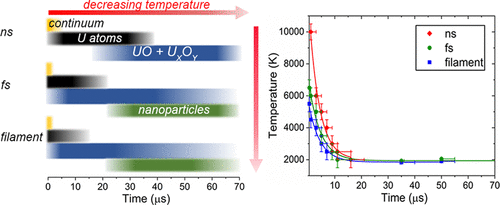当前位置:
X-MOL 学术
›
Anal. Chem.
›
论文详情
Our official English website, www.x-mol.net, welcomes your
feedback! (Note: you will need to create a separate account there.)
Unraveling spatio-temporal chemistry evolution in laser ablation plumes and its relation to initial plasma conditions.
Analytical Chemistry ( IF 6.7 ) Pub Date : 2020-09-22 , DOI: 10.1021/acs.analchem.0c02477 Elizabeth J Kautz 1 , Mark C Phillips 2, 3 , Sivanandan S Harilal 1
Analytical Chemistry ( IF 6.7 ) Pub Date : 2020-09-22 , DOI: 10.1021/acs.analchem.0c02477 Elizabeth J Kautz 1 , Mark C Phillips 2, 3 , Sivanandan S Harilal 1
Affiliation

|
The chemistry evolution in a laser ablation plume depends strongly on its initial physical conditions. In this article, we investigate the impact of plasma generation conditions on the interrelated phenomena of expansion dynamics, plasma chemistry, and physical conditions. Plasmas are produced from a uranium metal target in air using nanosecond, femtosecond, and femtosecond filament-assisted laser ablation. Time-resolved two-dimensional spectral imaging was performed to evaluate the spatio-temporal evolution of atoms, diatoms, polyatomic molecules, and nanoparticles in situ. Emission spectral features reveal that molecular formation occurs at early times in both femtosecond and filament ablation plumes, although with different temporal decays. In contrast, molecular formation is found to occur at much later times in nanosecond plasma evolution. Spectral modeling is used to infer temporal behavior of plasma excitation temperature. We find U atoms and UO molecules co-exist in ultrafast laser-produced plasmas even at early times after plasma onset owing to favorable temperatures for molecular formation. Regardless of irradiation conditions, plume emission features showed the presence of higher oxides (i.e., UxOy), although with different temporal histories. Our study provides insight into the impact of plasma generation conditions on chemistry evolution in plasmas produced from traditional focused femtosecond, nanosecond, and filament-assisted laser ablation.
中文翻译:

揭示激光烧蚀羽流中的时空化学演化及其与初始等离子体条件的关系。
激光烧蚀羽流中的化学变化在很大程度上取决于其初始物理条件。在本文中,我们研究了等离子体生成条件对膨胀动力学,等离子体化学和物理条件等相关现象的影响。等离子体是在空气中使用纳秒级,飞秒级和飞秒级的灯丝辅助激光烧蚀技术从铀金属靶产生的。执行时间分辨二维光谱成像以评估原位原子,硅藻,多原子分子和纳米粒子的时空演化。发射光谱特征表明,尽管在时间上有不同的衰减,但是在飞秒和细丝消融羽流中分子形成都是在早期发生的。相反,发现分子形成发生在纳秒等离子体演化的更晚时间。频谱建模用于推断等离子体激发温度的时间行为。我们发现,由于有利于分子形成的温度,即使在等离子体发作后的早期,U原子和UO分子也同时存在于超快激光产生的等离子体中。不论照射条件如何,羽流排放特征都表明存在较高的氧化物(即,Ux O y),尽管具有不同的时间历史。我们的研究提供了关于等离子体产生条件对传统聚焦飞秒,纳秒和细丝辅助激光烧蚀产生的等离子体中化学演化的影响的见解。
更新日期:2020-10-21
中文翻译:

揭示激光烧蚀羽流中的时空化学演化及其与初始等离子体条件的关系。
激光烧蚀羽流中的化学变化在很大程度上取决于其初始物理条件。在本文中,我们研究了等离子体生成条件对膨胀动力学,等离子体化学和物理条件等相关现象的影响。等离子体是在空气中使用纳秒级,飞秒级和飞秒级的灯丝辅助激光烧蚀技术从铀金属靶产生的。执行时间分辨二维光谱成像以评估原位原子,硅藻,多原子分子和纳米粒子的时空演化。发射光谱特征表明,尽管在时间上有不同的衰减,但是在飞秒和细丝消融羽流中分子形成都是在早期发生的。相反,发现分子形成发生在纳秒等离子体演化的更晚时间。频谱建模用于推断等离子体激发温度的时间行为。我们发现,由于有利于分子形成的温度,即使在等离子体发作后的早期,U原子和UO分子也同时存在于超快激光产生的等离子体中。不论照射条件如何,羽流排放特征都表明存在较高的氧化物(即,Ux O y),尽管具有不同的时间历史。我们的研究提供了关于等离子体产生条件对传统聚焦飞秒,纳秒和细丝辅助激光烧蚀产生的等离子体中化学演化的影响的见解。











































 京公网安备 11010802027423号
京公网安备 11010802027423号